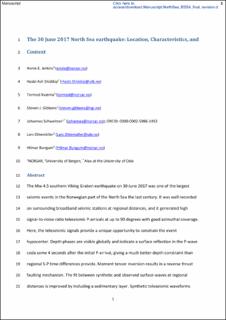| dc.contributor.author | Jerkins, Annie | |
| dc.contributor.author | Shiddiqi, Hasbi Ash | |
| dc.contributor.author | Kværna, Tormod | |
| dc.contributor.author | Gibbons, Steven John | |
| dc.contributor.author | Schweitzer, Johannes | |
| dc.contributor.author | Ottemöller, Lars | |
| dc.contributor.author | Bungum, Hilmar | |
| dc.date.accessioned | 2021-05-03T07:49:16Z | |
| dc.date.available | 2021-05-03T07:49:16Z | |
| dc.date.created | 2020-02-18T10:22:12Z | |
| dc.date.issued | 2020 | |
| dc.Published | Bulletin of The Seismological Society of America (BSSA). 2020, 110 (2), 937-952. | |
| dc.identifier.issn | 0037-1106 | |
| dc.identifier.uri | https://hdl.handle.net/11250/2740714 | |
| dc.description.abstract | The Mw 4.5 southern Viking graben earthquake on 30 June 2017 was one of the largest seismic events in the Norwegian part of the North Sea during the last century. It was well recorded on surrounding broadband seismic stations at regional distances, and it generated high signal-to noise ratio teleseismic P arrivals at up to 90° with good azimuthal coverage. Here, the teleseismic signals provide a unique opportunity to constrain the event hypocenter. Depth phases are visible globally and indicate a surface reflection in the P-wave coda some 4 s after the initial P arrival, giving a much better depth constraint than regional S-P time differences provide. Moment tensor inversion results in a reverse thrust faulting mechanism. The fit between synthetic and observed surface waves at regional distances is improved by including a sedimentary layer. Synthetic teleseismic waveforms generated based on the moment tensor solution, and a near-source 1D velocity model indicates a depth of 7 km. Correlation detectors using the S-wave coda from the main event were run on almost 30 yr of continuous multichannel seismic data searching for repeating signals. In addition to a magnitude 1.9 aftershock 33 min later, and a few magnitude ∼1 events in the following days, a magnitude 2.5 earthquake on 13 November 2016 was the only event found to match the 30 June 2017 event well. Using double-difference techniques, we find that the two largest events are located within 1 km of the main event. We present a Bayesloc probabilistic multiple event location including the 30 June event and all additional seismic events in the region well recorded on the regional networks. The Bayesloc relocation gave a more consistent seismicity pattern and moved several of the events more toward the west. The results of this study are also discussed within the regional seismotectonic frame of reference. | en_US |
| dc.language.iso | eng | en_US |
| dc.publisher | Seismological Society of America | en_US |
| dc.title | The 30 June 2017 North Sea Earthquake: Location, Characteristics, and Context | en_US |
| dc.type | Journal article | en_US |
| dc.type | Peer reviewed | en_US |
| dc.description.version | acceptedVersion | en_US |
| dc.rights.holder | Copyright 2020 Seismological Society of America | en_US |
| cristin.ispublished | true | |
| cristin.fulltext | postprint | |
| cristin.qualitycode | 1 | |
| dc.identifier.doi | 10.1785/0120190181 | |
| dc.identifier.cristin | 1795136 | |
| dc.source.journal | Bulletin of The Seismological Society of America (BSSA) | en_US |
| dc.source.40 | 110 | |
| dc.source.14 | 2 | |
| dc.source.pagenumber | 937-952 | en_US |
| dc.identifier.citation | Bulletin of The Seismological Society of America (BSSA). 2020, 110 (2): 937–952 | en_US |
| dc.source.volume | 110 | en_US |
| dc.source.issue | 2 | en_US |
